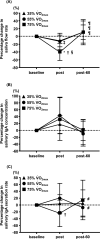Effects of different exercise intensities or durations on salivary IgA secretion
- PMID: 38634902
- PMCID: PMC11365859
- DOI: 10.1007/s00421-024-05467-6
Effects of different exercise intensities or durations on salivary IgA secretion
Abstract
Purpose: This study aimed to examine changes in salivary immunoglobulin A (s-IgA) secretion at different intensities or durations of acute exercise.
Methods: Twelve healthy untrained young males were included in randomized crossover trials in Experiment 1 (cycling exercise for 30 min at a work rate equivalent to 35%, 55%, and 75% maximal oxygen uptake [ O2max]) and Experiment 2 (cycling exercise at 55% O2max intensity for 30, 60, and 90 min). Saliva samples were collected at baseline, immediately after, and 60 min after each exercise.
Results: Experiment 1: The percentage change in the s-IgA secretion rate in the 75% O2max trial was significantly lower than that in the 55% O2max trial immediately after exercise (- 45.7%). The percentage change in the salivary concentration of cortisol, an s-IgA regulating factor, immediately after exercise significantly increased compared to that at baseline in the 75% O2max trial (+ 107.6%). A significant negative correlation was observed between the percentage changes in saliva flow rate and salivary cortisol concentration (r = - 0.52, P < 0.01). Experiment 2: The percentage change in the s-IgA secretion rate in the 90-min trial was significantly lower than that in the 30-min trial immediately after exercise (-37.0%). However, the percentage change in salivary cortisol concentration remained the same.
Conclusion: Our findings suggest that a reduction in s-IgA secretion is induced by exercise intensity of greater than or equal to 75% O2max for 30 min or exercise duration of greater than or equal to 90 min at 55% O2max in healthy untrained young men.
Keywords: Exercise duration; Exercise intensity; Open window; Oral immune function; Salivary IgA.
© 2024. The Author(s).
Conflict of interest statement
The authors declare no conflicts of interest. The results of this study are presented clearly, honestly, and without fabrication, falsification, or inappropriate data manipulation.
Figures






References
-
- American College of Sports Medicine (2000) American College of Sports Medicine’s Guidelines for Exercise Testing and Prescription. 6th ed. Baltimore, Maryland.
Publication types
MeSH terms
Substances
Grants and funding
LinkOut - more resources
Full Text Sources
Medical
Miscellaneous

